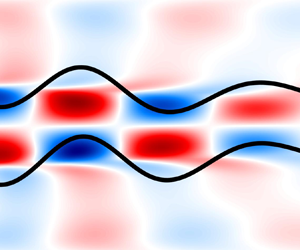Published online by Cambridge University Press: 25 March 2021

A framework for the computation of linear global modes, based on time stepping of a linearised Navier–Stokes solver with an Eulerian interface representation, is presented. The method is derived by linearising the nonlinear solver Basilisk, capable of computing immiscible two-phase flows, and offers several advantages over previous, matrix-based, multi-domain approaches to linear global stability analysis of interfacial flows. Using our linear solver, we revisit the study of Tammisola et al. (J. Fluid Mech., vol. 713, 2012, pp. 632–658), who found a counter-intuitive, destabilising effect of surface tension in planar wakes. Since their original study does not provide any validation, we further compute nonlinear results for the studied flows. We show that a surface-tension-induced destabilisation of plane wakes is observable which leads to periodic, quasiperiodic or chaotic oscillations depending on the Weber number of the flow. The predicted frequencies of the linear global modes, computed in the present study, are in good agreement with the nonlinear results, and the growth rates are comparable to the disturbance growth in the nonlinear flow before saturation. The bifurcation points of the nonlinear flow are captured accurately by the linear solver and the present results are as well in correspondence with the study of Tammisola et al. (J. Fluid Mech., vol. 713, 2012, pp. 632–658).